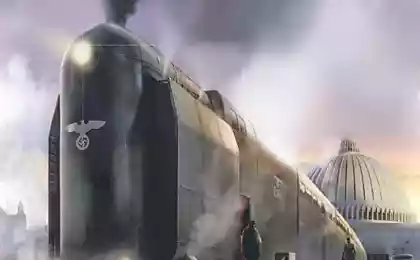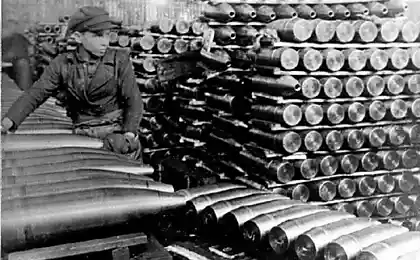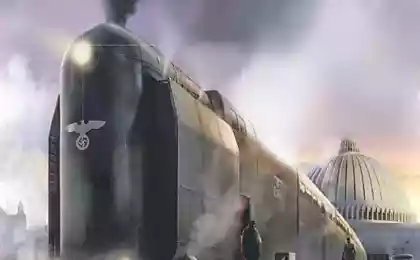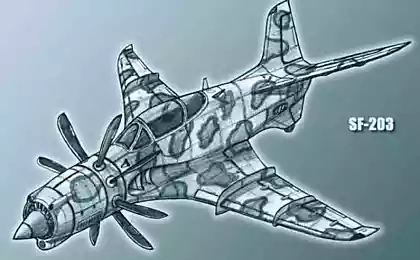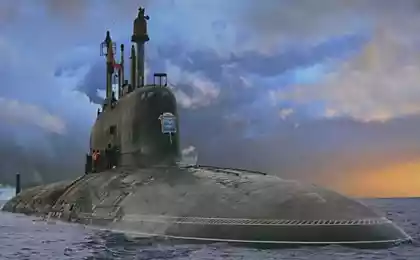1351
Little-known planes of the Third Reich
55 photos + text
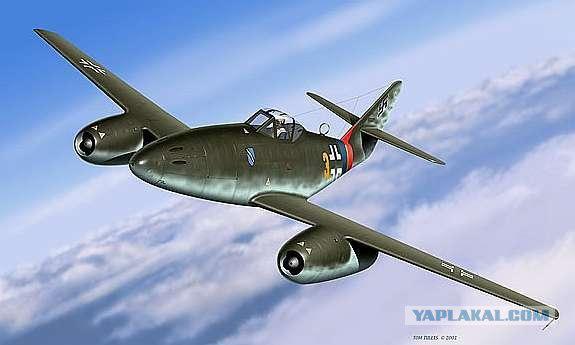
02
Arado Ar 234 "Blitz»
Among the many interesting aircraft designs that have appeared during the Second World War occupies a special place German aircraft with jet engines Ar-234. Originally designed as a reconnaissance vehicle, it was used as a bomber, and even planned on the role of the night fighter, attack aircraft carrier, and even missiles. He has had a significant impact on the design of aircraft companies appeared in the United States, Britain, France and the former Soviet Union. With the exception of samples of missile technology, jet aircraft developed in the Third Reich were the most tasty morsel for the Allies - reactive Ar-234 and ME-262 «Schwalbe» were the most sought-winning
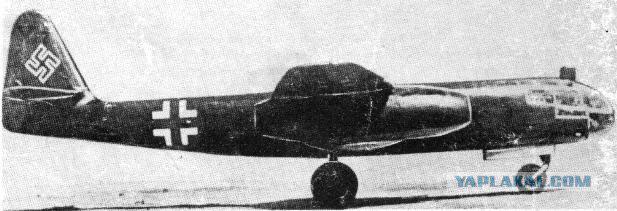
03
The most important advantage possessed by new propulsion systems, will be able to give the aircraft an extraordinary speed, almost twice exceeding the one that has a modern fighter aircraft with piston engines. Obviously, primarily this ability would be useful fighter aircraft.
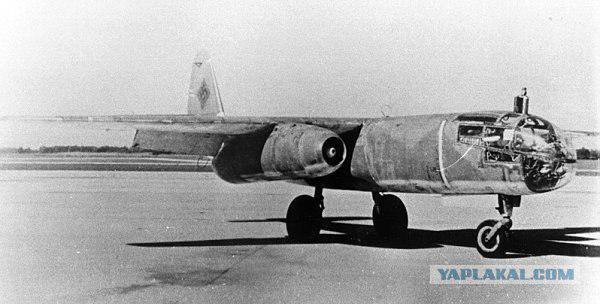
04
Work on the project, the designation E-370, were delayed due to the two other tasks, issued RLM -pazrabotki transport plane Ar-232 Fighter - Ar-240. Therefore, only in September 1941 crystallized technical proposal - under the code E-370 / IV. It was supposed to be single reconnaissance aircraft, equipped with two engines BMW P-3302 (in the series under the designation BMW 003), with a launch weight of 7000 kg reaches. Three fuel tanks in the wings, and three in the fuselage that can accommodate a total of 4,000 liters of fuel. Intelligence equipment was to consist of two types of cameras Rb 50/30 or Rb 75/30, placed at the rear of the fuselage. Defensive armament was limited to only one machine gun MG 13 caliber 131 mm in the rear, and so it was a concession as compared with the original proposal, in which the aircraft does not have defensive weapons. He was supposed to be so fast that he did not need a defensive machine guns that would protect themselves against allied fighters.
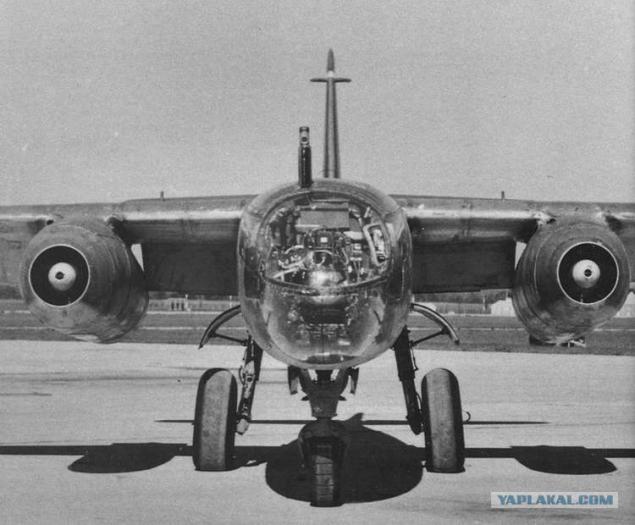
05
November 26, 1943, Hitler was scheduled to visit the airfield in Insterburg (Insterburg), which was exhibited the latest aviation technology. Apart from the two jet Me-262, Me-163 rocket, a flying bomb Fi-103 (V1), and a number of prototypes of rockets, it was decided to show him also Ar-234. November 21 the third prototype was dismantled and transported to the place of display. Hitler, under the impression demonstrated his designs, decided that before the end of 1944 to be built 200 units Ar-234. In a conversation on this subject Fuhrer used the word «blitz» (Lightning), which is passed to the next plane. Just as in the case of the Me-262 «Schwalbe», it is true, there is not an official name. In official documents were later used as the name of the «Hecht» (Pike).
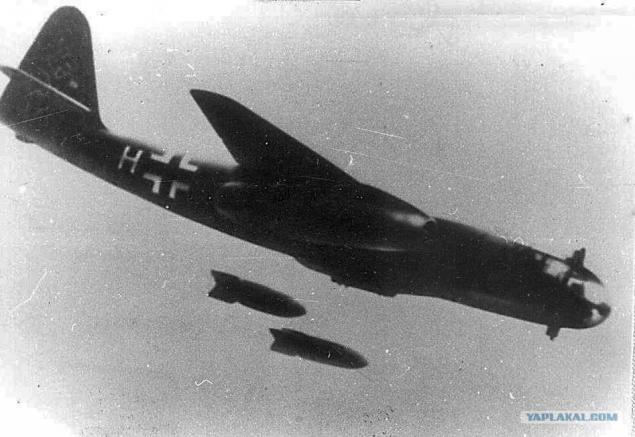
06
August 2nd, 1944 performed the first in the history of combat reconnaissance flight jet; his driver was Oblt. Erich Sommer (Erich Sommer). Then Ar-234 V-7 flying until November 19, 1944, then it was written off.
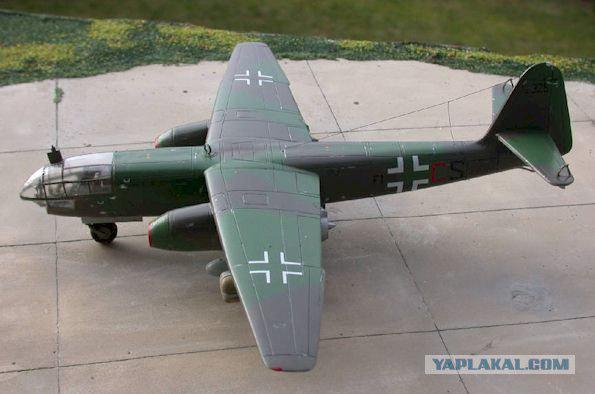
07
Bachem Ba 349 "Natter»
Ba 349, in accordance with the requirements of the German Air Ministry for use as a fighter-interceptor, counteracting raids by Allied bombers had relatively primitive fuselage, as the emphasis was on the ease of manufacturing the unskilled workers. Lateral control was provided by the elevators. The fuselage was installed sustainer rocket engine "Walter" 109-509A-2, able to develop within 70 to 16 pull 68 kN and for long flights to use low-thrust mode (1, 47 kN). The plane was supposed to run vertically by aligning in pairs on each side of the fuselage with four solid booster motors "Shmidding" 109-533, each for 10 seconds, I developed a thrust 11 kN 77, after which they were separated.
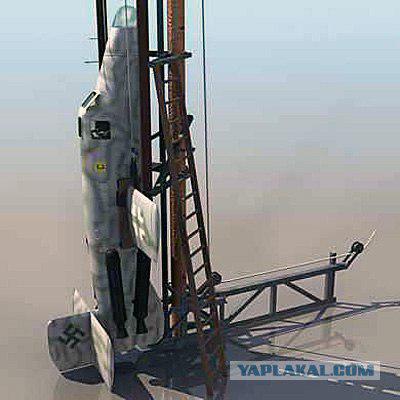
08
The first of 15 prototypes of the aircraft was released in October 1944. It was used for the handling and testing of non-motorized towed aircraft "Heinkel" No 111. The first vertical takeoff unmanned, starting with the launch and propulsion rocket motors, held February 23, 1945 goda.Cherez few days, practically the only (at the time) manned aircraft vertical take-off, the canopy blew off in flight, and the aircraft from a height of 1,525 m hit the ground, a test pilot Lothar Siebert died.

09
The tactics of fighting "Viper" assumed a vertical take-off on the autopilot, and the pilot allowed the transition to manual control for taking a position at a higher altitude than the one who flew the bombers. For shooting with shallow dive "Viper" is equipped to shoot the bow, which was located under the unit with unguided rockets. After launching missiles empty plane left the battle zone, and the pilot could not unfasten the straps. By moving the control stick forward, the pilot opened the safety latches, then releases the mechanical locks, and the nose of the entirely separated from the fuselage. The pilot left the aircraft without difficulty, because the tail of the car through the issue of a rescue parachute brake decelerates. The tail section was to be used again.
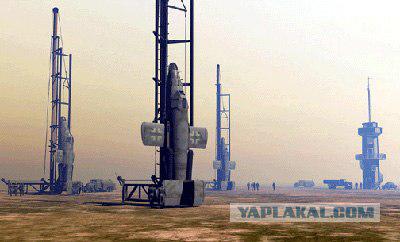
10
Ba 349A is the initial serial version. Luftwaffe has ordered 50 aircraft and security of the CC-150. It was made about 36 "Viper", but no car was not involved in the fighting, despite the fact that 10 have been prepared to run and Kirchheim. But the Allied tanks reached the airfield too close, so interceptors were destroyed right in the parking lot in order to avoid capture and use.
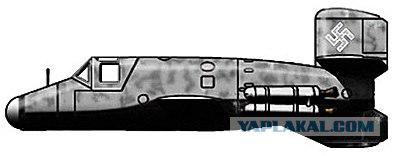
Ba 349V is an improved modification, the area had increased the tail and a more powerful rocket engine "Walter" 109-509S, develops a maximum thrust 19, 62 kN and allows it drosserirovanie to 1, 96 kN. There were three manufactured aircraft.
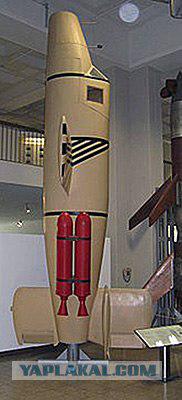
13
Fieseler Fi 103R «Reichenberg»
Fieseler Fi 103R Reichenberg
Fi 103RSozdanny joint efforts of firms "Fieseler" and "Argus" flying bomb FZG-76, also known under the designation Fi-103 and V-1 (V-1) in spite of the low accuracy and poor reliability proved to be a formidable weapon. His first application of the cities of England was a big surprise, and had a strong psychological impact on the British. However, soon the air defense of the British Isles has been reoriented to fight with these weapons, and by the beginning of September 1944 made good progress in the fight against the German flying bomb. It was a triumph on 28 August, when 97 of the detected V-1 destroyed 87 of these machines. Also perfect organization the British air defenses that contributed to the relatively low speed of the aircraft projectile (about 640 km / h) and the fact that the flight he could only move along a straight path without making any maneuvers and making no attempt to evade the attacks fighter nepriyatelya.Poetomu nae surprisingly, after adopting a ballistic missile V-2 (V-2), the question arose about the future use of the V-1.

14
Some of them, it was decided to start with the bombers, not 111. These bombers were to take positions for the start-aircraft shells at areas, covered lower air defense forces and thus provide a breakthrough system of air defense. In addition, the famous German aviator Hanna Reitsch proposed the establishment of a manned flying bomb to deal with large surface targets. Such a flying bomb was brought into the area following the enemy ships bomber He-111, after which the aircraft are fired projectile. Its pilot had to take it over, to clean aircraft missile at the target and bailed.
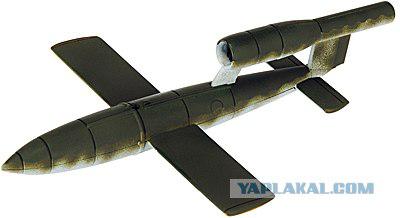
15
Command of the SS supported the idea, proposed the use of a manned flying bomb for the bombing of industrial complexes Kuibyshev, Chelyabinsk, Magnitogorsk, and the areas located east of the Urals. The well-known expert in sabotage O.Skortseni even ordered recruit and train 250 pilots bombers for these aircraft usually snaryadov.Kak in the Third Reich, the "original" idea was supported at the highest levels and was codenamed "Reichenberg", and the firm "Fieseler" was given the task to develop a manned flying bomb. Thanks to the firm "Fieseler 'experience in the design of aircraft and the widespread use of components and assemblies V-1, the job failed for 14 days. This developed four versions of a manned flying bombs, the designation Fi-103R (Reichenberg):
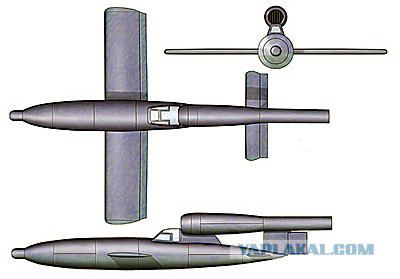
16
In principle, all four aircraft modifications have the same design that was largely borrowed from the V-1: a monoplane with a cantilever mid-wing, cigar-shaped fuselage and tail odnokilevym opereniem.Fyuzelyazh was built almost entirely of low-carbon steel, and the wings were removable wooden structure They were mounted on the main spars of steel pipes immediately before the suspension of the aircraft under the wing-shell-not 111. The engine served Pulsejet "Argus", which developed a thrust of about 226 kg with the flight speed of 640 km / h. This engine is a tube of mild steel length of 3, 48 m with a maximum diameter of a little more than 546 mm. Nozzle diameter was 40 cm, the thickness of the pattern adopted when manufacturing the steel is 2 to 5 mm. The weight of the engine does not exceed 163 kg.
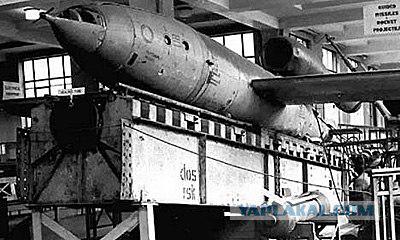
17
At the front end of the pipe install the valve grille for air intake, which rose valves, opens like a sash made of carbon steel. At the head of the pipe 9 there injector for injecting fuel connected to the tank by means of the fuel. Since the opening of the valves exactly matched lattice point fuel injection, thereby providing the duty cycle of the engine. Fuel was supplied under pressure of about 6 atm, the ratio of components of the fuel-air mixture was about 1:15.

18
In early 1946, on the instructions of the Soviet administration formed a German designer of OKB-1 in Dessau has developed on the basis of Fi-103R easy to attack EF-126. Repeating mainly designs its counterpart, the aircraft had spaced dvuhkilevoe empennage, and the cockpit was located in the front part of the fuselage. Assault Weapons consisted of only two 20-mm guns. For take-off has developed a special catapult and landing was to be made to the landing skid.

19
First flight EF-126 took place on May 21, 1946. Although this flight ended in a catastrophe that killed the test pilot, flew the modified samples pretty well. Nevertheless, a government commission headed by Yakovlev gave a negative opinion on the draft of the aircraft, "weak weapons, the lack of armor and insufficient supply of fuel hamper the use of aircraft" S-126 "as a mass attack aircraft." Thus ended the story of one of several jets of the Luftwaffe, which were placed very high expectations.
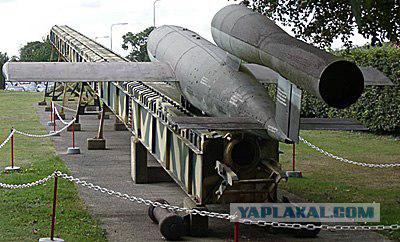
20

21
Heinkel He 162 "Salamander»
In the fall of 1944, the weakness of the fascist system of air defense became obvious to management in the Third Reich, the German Air Ministry decided to organize a competition for the creation of a jet fighter, which was planned to produce in large quantities - from 1,000 to 5,000 units per month.
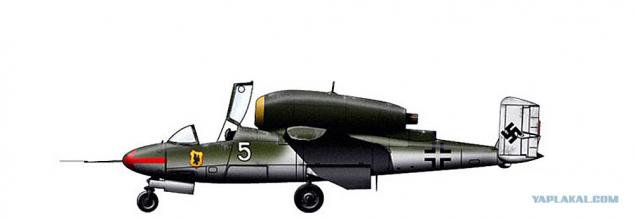
Among other requirements called the ease of piloting, simplicity of equipment and cheaper production. What is interesting - it is a jet fighter, it was decided to use wood for the wings.
The firm "Heinkel" conditions of competition have been received on September 8 and September 24 based in Vienna, a group of designers that the company has already started design studies of the aircraft is not 162, the factory received the name "Salamander". By the beginning of November of the same year, working drawings were ready, and when ready drawings produced production of aircraft components and assemblies. This has allowed to finish work on a prototype aircraft has 6 December 1944. On the same day the plane was hoisted into the air.
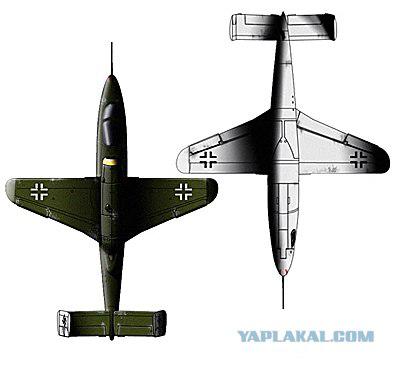
23
A feature of this jet fighter was also the fact that the engine of the aircraft was located above the fuselage, the car was also low three-wheeled chassis, rectangular outline dual vertical tail and a V-shaped horizontal tail. Wing wood with plywood sheathing thickness of 4-5 mm. To improve the Stability wing tips are bent downwards. Between the fuselage and the ailerons are located metallic flaps. Fuselage - duralyuminovy monocoque with reinforcements in places cuts. The nose cone of the fuselage in front of the cockpit wooden. Metallic horizontal tail and vertical wood. All the tail with a tail part of the fuselage can be rotated about the transverse horizontal axis through an angle of 3 ° to -2 ° for longitudinal balancing plane. The aircraft is a turbojet engine BMW-003E1.

24
945 liters of fuel stocks, of which 763 liters are in the fuselage tank, established for the pilot's seat, and 182l - two wing tanks. Nose wheel and main landing gear retracted into the fuselage. Arming located in the forward fuselage laterally pilot seat, consists of two 30 mm caliber guns with a supply of cartridges 50 or two guns with a caliber of 20 mm margin of 120 cartridges. This 30-mm cannons MK-108 planes were armed with the first production series He-162A-1, released in relatively small quantities. This is because the recoil when firing guns was too large and require amplification nose of the aircraft.
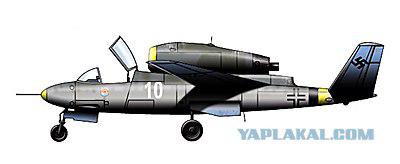
25
The second production version Non-162A-2 was armed with 20-mm cannon MG-151, and at the end of the war there was a modification of the Non-162A-3, with a reinforced nose section, which have been re-established 30-mm cannons MK-108. Held in December 1944 and January 1945, flight tests have shown that the aircraft has good handling and is able to develop the speed from the ground up to 885-890 km / h and at an altitude of 6000 m - up to 905 km / h. Given the fact that at a speed of more than 600 km / h, the opportunity to leave the cockpit in case of an accident for the pilot almost completely eliminated, the cabin is equipped with ejector seat, driving the powder gases from the squib. Production of non-162 aircraft, which was given the official name "Folkseger" - "People's Fighter" - received priority over all other programs the issue of weapons, it was supposed to be made in the amount of 1,000-5,000 units per month. For this purpose, the plants were Heinkel cooperated with more than 700 companies that have been supplying them to each other and mutually parts, components and separate basic units such as wings, tail itp
Each of the companies received a tough task in terms of production, sought to simplify the design of manufactured products and adapt them to the technology adopted in the enterprise. For example, in the factory of the company "Gotha Vaggon factory", which was asked to produce a wing of the aircraft, it was found that the existing design of an airplane wing non-162 (a wooden, single-spar wing usual scheme) proved time-consuming, and production cycle is so long that it is prevented the implementation of the above program output in the shortest possible time. Therefore, at this plant it was designed and constructed a new wing monobloc. With streamlined production team of 12 workers could produce a set of wing panels for every 8 minutes. To ensure the release of fighters Not-162 and under incessant enemy air attacks, most companies was located underground.

26
For example, in the abandoned gypsum mines in Mödling, near Vienna allies assembly plant has been found in the shops is in various stages of readiness are more than 1,000 fighters Not-162. Serial production of fighter He-162 was launched in January 1945, when they were made the first 6 production aircraft. By the end of the war parts of the Luftwaffe was transferred about 120 machines and more than 200 aircraft were manufactured factory flight tests. More or less reliable data about the combat use of "People's Fighter" available, but there are reports indicating numerous accidents and catastrophes of the aircraft due to constructional errors and manufacturing defects.
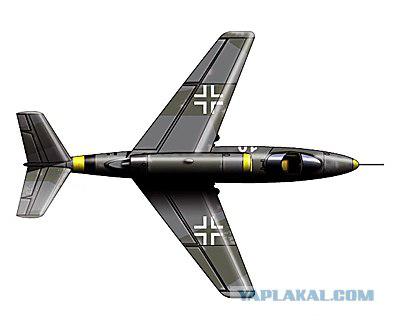
27
28
29
30
31
32
32
33
34
37
38
39
41
42
42
43
44
45
46
48
49
Thank
Source:

02
Arado Ar 234 "Blitz»
Among the many interesting aircraft designs that have appeared during the Second World War occupies a special place German aircraft with jet engines Ar-234. Originally designed as a reconnaissance vehicle, it was used as a bomber, and even planned on the role of the night fighter, attack aircraft carrier, and even missiles. He has had a significant impact on the design of aircraft companies appeared in the United States, Britain, France and the former Soviet Union. With the exception of samples of missile technology, jet aircraft developed in the Third Reich were the most tasty morsel for the Allies - reactive Ar-234 and ME-262 «Schwalbe» were the most sought-winning

03
The most important advantage possessed by new propulsion systems, will be able to give the aircraft an extraordinary speed, almost twice exceeding the one that has a modern fighter aircraft with piston engines. Obviously, primarily this ability would be useful fighter aircraft.

04
Work on the project, the designation E-370, were delayed due to the two other tasks, issued RLM -pazrabotki transport plane Ar-232 Fighter - Ar-240. Therefore, only in September 1941 crystallized technical proposal - under the code E-370 / IV. It was supposed to be single reconnaissance aircraft, equipped with two engines BMW P-3302 (in the series under the designation BMW 003), with a launch weight of 7000 kg reaches. Three fuel tanks in the wings, and three in the fuselage that can accommodate a total of 4,000 liters of fuel. Intelligence equipment was to consist of two types of cameras Rb 50/30 or Rb 75/30, placed at the rear of the fuselage. Defensive armament was limited to only one machine gun MG 13 caliber 131 mm in the rear, and so it was a concession as compared with the original proposal, in which the aircraft does not have defensive weapons. He was supposed to be so fast that he did not need a defensive machine guns that would protect themselves against allied fighters.

05
November 26, 1943, Hitler was scheduled to visit the airfield in Insterburg (Insterburg), which was exhibited the latest aviation technology. Apart from the two jet Me-262, Me-163 rocket, a flying bomb Fi-103 (V1), and a number of prototypes of rockets, it was decided to show him also Ar-234. November 21 the third prototype was dismantled and transported to the place of display. Hitler, under the impression demonstrated his designs, decided that before the end of 1944 to be built 200 units Ar-234. In a conversation on this subject Fuhrer used the word «blitz» (Lightning), which is passed to the next plane. Just as in the case of the Me-262 «Schwalbe», it is true, there is not an official name. In official documents were later used as the name of the «Hecht» (Pike).

06
August 2nd, 1944 performed the first in the history of combat reconnaissance flight jet; his driver was Oblt. Erich Sommer (Erich Sommer). Then Ar-234 V-7 flying until November 19, 1944, then it was written off.

07
Bachem Ba 349 "Natter»
Ba 349, in accordance with the requirements of the German Air Ministry for use as a fighter-interceptor, counteracting raids by Allied bombers had relatively primitive fuselage, as the emphasis was on the ease of manufacturing the unskilled workers. Lateral control was provided by the elevators. The fuselage was installed sustainer rocket engine "Walter" 109-509A-2, able to develop within 70 to 16 pull 68 kN and for long flights to use low-thrust mode (1, 47 kN). The plane was supposed to run vertically by aligning in pairs on each side of the fuselage with four solid booster motors "Shmidding" 109-533, each for 10 seconds, I developed a thrust 11 kN 77, after which they were separated.

08
The first of 15 prototypes of the aircraft was released in October 1944. It was used for the handling and testing of non-motorized towed aircraft "Heinkel" No 111. The first vertical takeoff unmanned, starting with the launch and propulsion rocket motors, held February 23, 1945 goda.Cherez few days, practically the only (at the time) manned aircraft vertical take-off, the canopy blew off in flight, and the aircraft from a height of 1,525 m hit the ground, a test pilot Lothar Siebert died.

09
The tactics of fighting "Viper" assumed a vertical take-off on the autopilot, and the pilot allowed the transition to manual control for taking a position at a higher altitude than the one who flew the bombers. For shooting with shallow dive "Viper" is equipped to shoot the bow, which was located under the unit with unguided rockets. After launching missiles empty plane left the battle zone, and the pilot could not unfasten the straps. By moving the control stick forward, the pilot opened the safety latches, then releases the mechanical locks, and the nose of the entirely separated from the fuselage. The pilot left the aircraft without difficulty, because the tail of the car through the issue of a rescue parachute brake decelerates. The tail section was to be used again.

10
Ba 349A is the initial serial version. Luftwaffe has ordered 50 aircraft and security of the CC-150. It was made about 36 "Viper", but no car was not involved in the fighting, despite the fact that 10 have been prepared to run and Kirchheim. But the Allied tanks reached the airfield too close, so interceptors were destroyed right in the parking lot in order to avoid capture and use.

Ba 349V is an improved modification, the area had increased the tail and a more powerful rocket engine "Walter" 109-509S, develops a maximum thrust 19, 62 kN and allows it drosserirovanie to 1, 96 kN. There were three manufactured aircraft.

13
Fieseler Fi 103R «Reichenberg»
Fieseler Fi 103R Reichenberg
Fi 103RSozdanny joint efforts of firms "Fieseler" and "Argus" flying bomb FZG-76, also known under the designation Fi-103 and V-1 (V-1) in spite of the low accuracy and poor reliability proved to be a formidable weapon. His first application of the cities of England was a big surprise, and had a strong psychological impact on the British. However, soon the air defense of the British Isles has been reoriented to fight with these weapons, and by the beginning of September 1944 made good progress in the fight against the German flying bomb. It was a triumph on 28 August, when 97 of the detected V-1 destroyed 87 of these machines. Also perfect organization the British air defenses that contributed to the relatively low speed of the aircraft projectile (about 640 km / h) and the fact that the flight he could only move along a straight path without making any maneuvers and making no attempt to evade the attacks fighter nepriyatelya.Poetomu nae surprisingly, after adopting a ballistic missile V-2 (V-2), the question arose about the future use of the V-1.

14
Some of them, it was decided to start with the bombers, not 111. These bombers were to take positions for the start-aircraft shells at areas, covered lower air defense forces and thus provide a breakthrough system of air defense. In addition, the famous German aviator Hanna Reitsch proposed the establishment of a manned flying bomb to deal with large surface targets. Such a flying bomb was brought into the area following the enemy ships bomber He-111, after which the aircraft are fired projectile. Its pilot had to take it over, to clean aircraft missile at the target and bailed.

15
Command of the SS supported the idea, proposed the use of a manned flying bomb for the bombing of industrial complexes Kuibyshev, Chelyabinsk, Magnitogorsk, and the areas located east of the Urals. The well-known expert in sabotage O.Skortseni even ordered recruit and train 250 pilots bombers for these aircraft usually snaryadov.Kak in the Third Reich, the "original" idea was supported at the highest levels and was codenamed "Reichenberg", and the firm "Fieseler" was given the task to develop a manned flying bomb. Thanks to the firm "Fieseler 'experience in the design of aircraft and the widespread use of components and assemblies V-1, the job failed for 14 days. This developed four versions of a manned flying bombs, the designation Fi-103R (Reichenberg):

16
In principle, all four aircraft modifications have the same design that was largely borrowed from the V-1: a monoplane with a cantilever mid-wing, cigar-shaped fuselage and tail odnokilevym opereniem.Fyuzelyazh was built almost entirely of low-carbon steel, and the wings were removable wooden structure They were mounted on the main spars of steel pipes immediately before the suspension of the aircraft under the wing-shell-not 111. The engine served Pulsejet "Argus", which developed a thrust of about 226 kg with the flight speed of 640 km / h. This engine is a tube of mild steel length of 3, 48 m with a maximum diameter of a little more than 546 mm. Nozzle diameter was 40 cm, the thickness of the pattern adopted when manufacturing the steel is 2 to 5 mm. The weight of the engine does not exceed 163 kg.

17
At the front end of the pipe install the valve grille for air intake, which rose valves, opens like a sash made of carbon steel. At the head of the pipe 9 there injector for injecting fuel connected to the tank by means of the fuel. Since the opening of the valves exactly matched lattice point fuel injection, thereby providing the duty cycle of the engine. Fuel was supplied under pressure of about 6 atm, the ratio of components of the fuel-air mixture was about 1:15.

18
In early 1946, on the instructions of the Soviet administration formed a German designer of OKB-1 in Dessau has developed on the basis of Fi-103R easy to attack EF-126. Repeating mainly designs its counterpart, the aircraft had spaced dvuhkilevoe empennage, and the cockpit was located in the front part of the fuselage. Assault Weapons consisted of only two 20-mm guns. For take-off has developed a special catapult and landing was to be made to the landing skid.

19
First flight EF-126 took place on May 21, 1946. Although this flight ended in a catastrophe that killed the test pilot, flew the modified samples pretty well. Nevertheless, a government commission headed by Yakovlev gave a negative opinion on the draft of the aircraft, "weak weapons, the lack of armor and insufficient supply of fuel hamper the use of aircraft" S-126 "as a mass attack aircraft." Thus ended the story of one of several jets of the Luftwaffe, which were placed very high expectations.

20

21
Heinkel He 162 "Salamander»
In the fall of 1944, the weakness of the fascist system of air defense became obvious to management in the Third Reich, the German Air Ministry decided to organize a competition for the creation of a jet fighter, which was planned to produce in large quantities - from 1,000 to 5,000 units per month.

Among other requirements called the ease of piloting, simplicity of equipment and cheaper production. What is interesting - it is a jet fighter, it was decided to use wood for the wings.
The firm "Heinkel" conditions of competition have been received on September 8 and September 24 based in Vienna, a group of designers that the company has already started design studies of the aircraft is not 162, the factory received the name "Salamander". By the beginning of November of the same year, working drawings were ready, and when ready drawings produced production of aircraft components and assemblies. This has allowed to finish work on a prototype aircraft has 6 December 1944. On the same day the plane was hoisted into the air.

23
A feature of this jet fighter was also the fact that the engine of the aircraft was located above the fuselage, the car was also low three-wheeled chassis, rectangular outline dual vertical tail and a V-shaped horizontal tail. Wing wood with plywood sheathing thickness of 4-5 mm. To improve the Stability wing tips are bent downwards. Between the fuselage and the ailerons are located metallic flaps. Fuselage - duralyuminovy monocoque with reinforcements in places cuts. The nose cone of the fuselage in front of the cockpit wooden. Metallic horizontal tail and vertical wood. All the tail with a tail part of the fuselage can be rotated about the transverse horizontal axis through an angle of 3 ° to -2 ° for longitudinal balancing plane. The aircraft is a turbojet engine BMW-003E1.

24
945 liters of fuel stocks, of which 763 liters are in the fuselage tank, established for the pilot's seat, and 182l - two wing tanks. Nose wheel and main landing gear retracted into the fuselage. Arming located in the forward fuselage laterally pilot seat, consists of two 30 mm caliber guns with a supply of cartridges 50 or two guns with a caliber of 20 mm margin of 120 cartridges. This 30-mm cannons MK-108 planes were armed with the first production series He-162A-1, released in relatively small quantities. This is because the recoil when firing guns was too large and require amplification nose of the aircraft.

25
The second production version Non-162A-2 was armed with 20-mm cannon MG-151, and at the end of the war there was a modification of the Non-162A-3, with a reinforced nose section, which have been re-established 30-mm cannons MK-108. Held in December 1944 and January 1945, flight tests have shown that the aircraft has good handling and is able to develop the speed from the ground up to 885-890 km / h and at an altitude of 6000 m - up to 905 km / h. Given the fact that at a speed of more than 600 km / h, the opportunity to leave the cockpit in case of an accident for the pilot almost completely eliminated, the cabin is equipped with ejector seat, driving the powder gases from the squib. Production of non-162 aircraft, which was given the official name "Folkseger" - "People's Fighter" - received priority over all other programs the issue of weapons, it was supposed to be made in the amount of 1,000-5,000 units per month. For this purpose, the plants were Heinkel cooperated with more than 700 companies that have been supplying them to each other and mutually parts, components and separate basic units such as wings, tail itp
Each of the companies received a tough task in terms of production, sought to simplify the design of manufactured products and adapt them to the technology adopted in the enterprise. For example, in the factory of the company "Gotha Vaggon factory", which was asked to produce a wing of the aircraft, it was found that the existing design of an airplane wing non-162 (a wooden, single-spar wing usual scheme) proved time-consuming, and production cycle is so long that it is prevented the implementation of the above program output in the shortest possible time. Therefore, at this plant it was designed and constructed a new wing monobloc. With streamlined production team of 12 workers could produce a set of wing panels for every 8 minutes. To ensure the release of fighters Not-162 and under incessant enemy air attacks, most companies was located underground.

26
For example, in the abandoned gypsum mines in Mödling, near Vienna allies assembly plant has been found in the shops is in various stages of readiness are more than 1,000 fighters Not-162. Serial production of fighter He-162 was launched in January 1945, when they were made the first 6 production aircraft. By the end of the war parts of the Luftwaffe was transferred about 120 machines and more than 200 aircraft were manufactured factory flight tests. More or less reliable data about the combat use of "People's Fighter" available, but there are reports indicating numerous accidents and catastrophes of the aircraft due to constructional errors and manufacturing defects.

27
28
29
30
31
32
32
33
34
37
38
39
41
42
42
43
44
45
46
48
49
Thank
Source:
